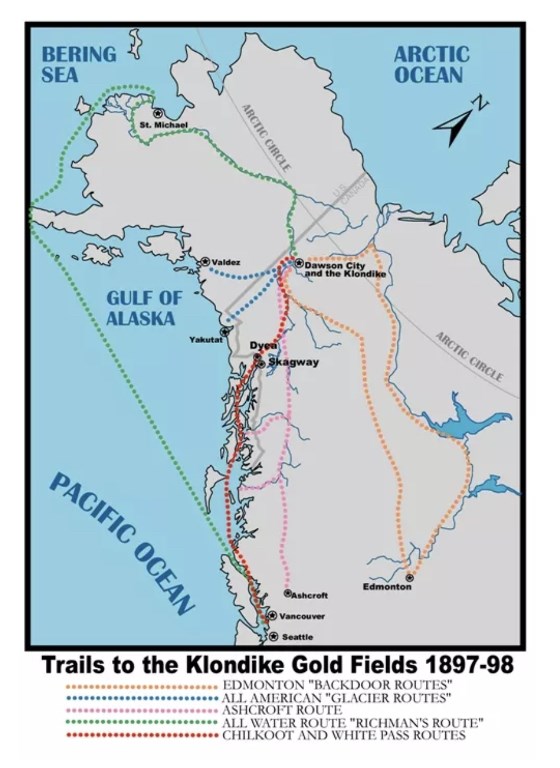
NPS National Historic Landmark status offers many benefits. NPS provides technical guidance to owners on the preservation of the site and may support documentation efforts. Property owners can also receive assistance preserving the historic character of their site through grants, tax credits, and other financial assistance. Designation helps bring public attention to the site. As of 2022, there are over 2,600 NHLs in the United States. The Skagway and White Pass District NHL represents the unique history of the Klondike Gold Rush. [Figure A] NPS works to improve the interpretation of the district’s history through preserving historic buildings, adding informative signs throughout town, developing museum exhibits and conducting surveys. 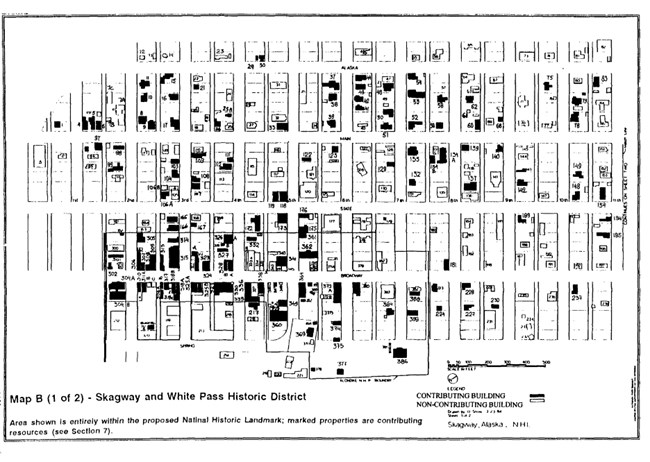
NPS Development of Skagway NHLThe Skagway and White Pass National Historic Landmark District was established on June 13, 1962. The district begins at Skagway Bay and ends at the Alaska/Canada border at White Pass summit. It includes historic resources within the original late-nineteenth century Skagway townsite and Skagway River Valley. This area was determined nationally significant under NHL Criteria 1 due to the town’s strong “association to a turning point or significant event in American history.” Skagway developed as the last stop for Gold Rush travelers embarking on the long and arduous journey to the Yukon. Its historic resources represent this history, together they provide an important example of an Alaskan frontier town. [Figure B]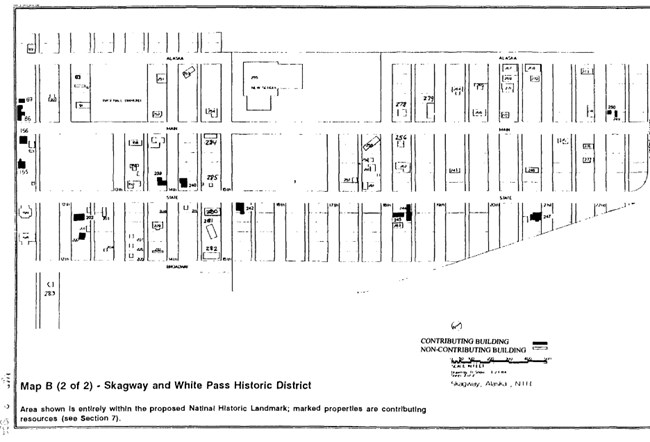
NPS 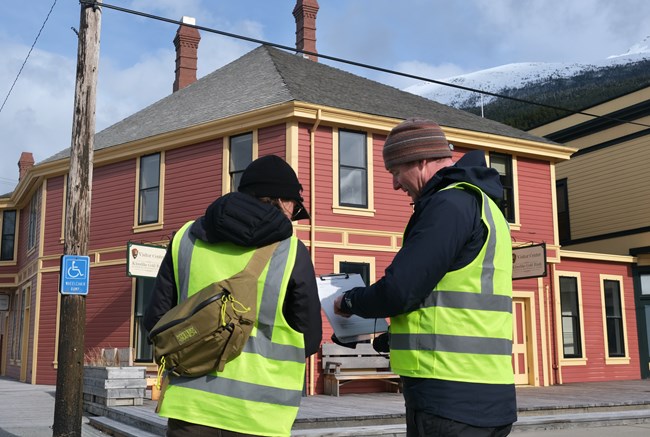
NPS Key Findings of National Historic Landmark (NHL) ResearchHistory is ever-changing. The National Historic Landmark Program recognizes places of national significance that express American cultural heritage. Through research and documentation, the program aims to protect and preserve our nationally significant cultural resources. As places and our interpretation of their history changes, it is important to continue the work of researching and surveying so that we might further understand their significance. [Figure D]The area that makes up modern day Skagway has a rich and dynamic indigenous history that far pre-dates the Klondike Gold Rush of the late nineteenth century. The Tlingit people of Southeast Alaska are intricately interwoven into the history of the development of Skagway as a Gold Rush era settlement. The original NHL nomination conducted in 1962 highlights the period of significance of the Skagway district as being 1897 to 1910, the era most closely associated with the Gold Rush years. While this period continues to be the focus of most recent survey, the updated 2022 NHL research has expanded the statement of significance to include the complex native socioeconomics of the area prior to Euro-American settlement. The research elaborates on how the relationship between those early settlers and the Tlingit people resulted in Skagway becoming a Gold Rush era settlement. The recent efforts to research and re-survey focused on resources that contribute directly to the Skagway and White Pass district as a Klondike Gold Rush settlement between the years of 1897 to 1910. Contributing resources include not only buildings but also structures, sites, and objects that retain the integrity necessary to convey the historic association with the Gold Rush period of significance. Exploring relationships between residences, commercial business, abandoned logging operations, and even railroad helps historians develop a more complete understanding of how the town of Skagway looked and functioned during those Stampeder years. The 2018-2022 re-survey efforts also provides important new insights into how the district as a whole changed since the previous NHL research conducted in 1998. The 1998 NHL research listed a total of 174 contributing resources to the Skagway and White Pass district including 163 buildings, 8 sites, and 3 structures. The 2022 compiled survey has identified 135 contributing resources including 130 buildings, 5 sites, and 8 archeological sites. These findings suggest a total of 39 contributing resources that have been lost over the last 24 years. The remaining contributing resources are concentrated around the harbor and the terminus of the White Pass & Yukon Railroad located in the southeastern portion of the town. A large percentage of the contributing resources are commercial and residential buildings. Most are wood framed with wood siding, wood windows, and wooden boardwalks. Their construction points to the integral role that wood as a building material played in the building of Skagway. Like many boomtowns of the American west, Skagway was not initially built with longevity in mind. When mines were exhausted or the wells ran dry, prospectors would move to new claims and boomtowns quickly turned to ghost towns. Wood was readily available or easy to ship and even easier to use in construction. It made it possible for Skagway to transform from a tent village to a developed town in the span of only a few short years. 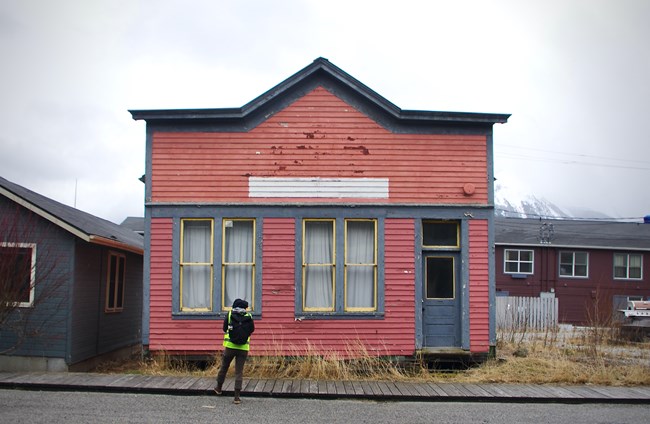
NPS The contributing commercial buildings of Skagway’s central business district, along Broadway Street between 1st and 7th Avenues, demonstrate more cohesive architectural styles and iconic features typical of the late nineteenth century. False fronts aligned side-by-side and adorned with cornices and brackets, pilasters and spindle work, all create the sense of a thriving commercial district during the time when thousands of Stampeders filled the streets. While many came to Skagway seeking fortunes in the Klondike gold claims, others came and started businesses to profit from the gold miners themselves. Store owners attracted customers with their goods polished in large display windows and recessed entry ways. Hand painted signs welcomed new-comers advertising full-service outfitting for their arduous journeys ahead. Hotels, taverns, barber shops, and brothels lined the main thoroughfare, each decorated to convey the sense of a flourishing enterprise. Contributing commercial businesses continue to display the town’s historic character. Many new constructions mimic these original stylistic features, providing a sense of continuity and cohesiveness to the central business district. Like Skagway’s residential buildings, many of these commercial buildings have been modified and adapted to contemporary needs. In some cases, Gold Rush era buildings have deteriorated and are in need of restoration or rehabilitation. [Figure E] Despite the ongoing alterations and loss of resources, the Skagway and White Pass National Historic Landmark District continues to retain many of the seven aspects of integrity as outlined by the National Register of Historic Places. Elements of location, setting, design, feeling and association to convey to the thousands of visitors each year a sense of what Skagway was like during the Klondike Gold Rush years of 1897 to 1910. 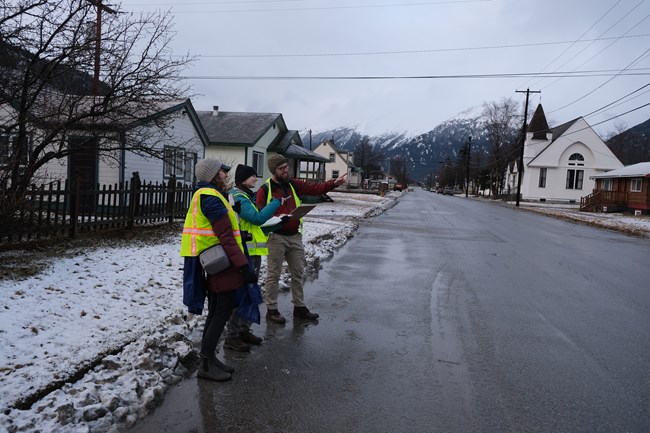
NPS SurveyingThe 1897 arrival of gold stampeders in Skagway marked a new chapter for this coastal town. Rapid population growth was accompanied by the construction of new buildings that housed miners and the businesses that served them on their way to the Klondike goldfields. After just a few years, the gold rush tapered off and the area began to attract tourists.In the 1930s, Skagway residents unsuccessfully appealed to the National Park Service to establish a park in the area. It wasn’t until the late 1950s that NPS included Skagway in the National Survey of Historic Sites and Buildings, and in 1962, designated the Skagway and White Pass District as a National Historic Landmark. Plans to create a Historical Park began in earnest in 1968 and included collecting data about the buildings in downtown Skagway with a specific interest in those built during the gold rush. The Historical Park was to contain the Skagway historic district and other gold rush-related sites and trails. President Gerald R. Ford signed legislation establishing the Klondike Gold Rush National Historical Park on June 30, 1976. A 1998 National Historic Landmark study documented 585 resources (including buildings, sites, and structures) within the Skagway and White Pass Historic District. Surveyors determined that 174 of these resources were part of the gold rush-era building boom and had also retained a high degree of historic integrity. The remaining 411 resources were either built after the Gold Rush era, or had deteriorated or been modified to a point where they no longer contributed significantly to the Historic District. The reports and surveys undertaken as part of the various historic designations in the twentieth century help the Park Service to serve as stewards of the area’s historic buildings and landscapes. They are important documents that need to be revisited periodically to document changes or losses to the built environment, particularly among surviving gold rush-era buildings. In 2018 and 2022, the National Park Service, Architectural Resources Group, and the University of Oregon’s Historic Preservation program undertook the most recent survey of Skagway. Teams, consisting of professionals and students with backgrounds in architecture and historic preservation, visited Skagway in March of those years to conduct site visits, comparing current conditions to those in past investigations. [Figure F] Surveyors worked in pairs, moving block-by-block through the town. The main task of a field surveyor is to record details about each property. While they might occasionally have opportunities to talk to homeowners and community members and learn about the buildings in Skagway, most of the information obtained during the survey is through observation of the town’s businesses and residences from the public right-of way. 
NPS Digital photographs and survey forms were labeled with a unique property lot number so that they can easily be referenced and located in the future. Team members converted information in the survey forms into a database to allow researchers to analyze the data collected in 2018 and 2022 and compare them to past investigations. This information will help the National Park Service and the community understand the changes that have occurred in Skagway’s historic district, and formulate plans to avoid further loss of Skagway’s unique Gold Rush history. |
Last updated: November 21, 2022
